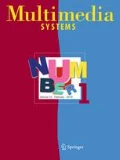Abstract
In this paper, we describe a pervasive treasure hunting game: “Team exploration” based on the Transhumance mobile ad-hoc network platform. The testers of this game came up with innovative suggestions that combined the technical features of the platform with their urban experience. They pointed to specific aspects of urban mobility that influence pervasive game design and contribute to the user’s pleasure. These tests show that the notion of space (geometrical organization) is not enough to characterize and organize pervasive games and that four main anthropological features have to be taken into consideration: the concrete city (physical organization), the imaginary city (narratives), the functional city (services) and the city events. The multilayered urban experience is also defined by our schedules (including repetitive or exceptional events) and by our assessment of other users (the distance or proximity as they are felt). These diverse aspects and qualifications of urban experience provide an interesting framework for the understanding of pervasive game experimentations, as well as point to new directions in pervasive game design. Our paper advocates that further anthropological observations are part of the pervasive game design methodology.





Similar content being viewed by others
Notes
2003–2005, ANR –RNRT, mobile ad-hoc network research project SAFARI.
References
Augé, M.: Non-lieux, Introduction à une Anthropologie de la Surmodernité. Seuil (1992)
Augoyard, J.-F.: Pas à pas. Essai sur le cheminement quotidien en milieu urbain. Editions du Seuil, Paris (1979)
Benford, S., Crabtree, A., Flintham, M., Drozd, A., Anastasi, R., Paxton, M., Tandavanitj, N., Adams, M., Row-Farr, J.: Can You See Me Now? Transactions on Computer–Human Interaction. ACM Press, New York (2006)
Bisignano, M., Di Modica, G., Tomarchio, O.: JMobiPeer: a middleware for mobile peer-to-peer computing. In: Proceedings of MANets. First International Workshop on Mobility in Peer-to-Peer Systems (MPPS) (ICDCSW’05), pp. 785–791 (2005)
Björk, S., Falk, J., Hansson, R., Ljungstrand, P.: Pirates! using the physical world as a game board. In: Proceedings of Interact’01 Conference, Tokyo, Japan, 9–13 July 2001. IFIP (2001)
Caillois, R.: Les jeux et les hommes. Le masque et le vertige. Gallimard, Paris (1967)
Certeau, M.: L’invention du quotidien 1- Arts de faire. Gallimard, Paris (1980)
Chalmers, M., Barkhuus, L., Bell, M., Brown, B., Hall, M., Sherwood, S., Tennent, P.: Gaming on the edge: using seams in pervasive games. In: Pergames, Magerkurth, C., Cheok, A.D., Nilsen, T., Mandryk R. (ed.) International Workshops on Pervasive Gaming Applications, Vienna (2005)
Clausen, T., Jacquet, P.: Optimized Link State Routing Protocol (OLSR). Technical Report RFC 3626, IETF (2003) UniK OLSR implementation. http://www.olsr.org
Demeure, I., Gentes, A., Guyot-Mbodji, A.: Transhumance: a platform on a mobile ad-hoc network challenging collaborative gaming. In: Proceedings of the International Symposium on Collaborative Technologies and Systems, Irvine, California, 19–23 May 2008. IEEE Press, New Jersey (2008)
Dourish, P.: Re-space-ing Place: Place and Space Ten Years On. CSCW’06, pp. 299–308. ACM Press, Banff (2006)
Feireiss, L.: Urban Free Flow. The Individual as an Active Performer. In: von Borries, F., Waltz, S.P., Böttger, M. (eds.) Space, Time, Play. Computer Games, Architecture and Urbanism: the Next Level. Birkhäuser Verlag, Basel (2007)
Fijalkow, Y.: Sociologie des villes. La Découverte, Paris (2007)
Gentès, A., Jutant, C.: pervasive gaming: testing future context aware applications. In: Castronova, E., Michaud L. (ed.) Communications & Strategies, New challenges for the vidéo game industry, n°73 (2009)
Girardin, F., Nova, N.: getting real with ubiquitous computing: the impact of discrepancies on collaboration. In: Eminds Issue, n°1 (2006)
Gold, R.: This is not a pipe. ACM. 36(7) (1993)
Jegers, K.: Pervasive Game Flow: Understanding Player Enjoyment in Pervasive Gaming. Computers in Entertainment. ACM Press, New York (2007)
Kaufmann, V., Bergman M., Joye, D.: Motility: mobility as capital. Int. J. Urban Reg. Res. 28, 745–756 (2004)
Khakpour, A. R., Demeure, I.: Chapar: A cross-layer overlay event system for MANETs. In: Proceedings of Mobilware 2009, Berlin (2009)
Khakpour, A.R., Demeure, I.: Designing and Prototyping an Event-based Communication System on Mobile Ad-Hoc Network. Technical Report 2008D009, Ecole Nationale Supérieure des Télécommunications, France (2008)
Licoppe, C., Inada, Y.: Les usages émergents d’un jeu multijoueurs sur terminaux mobiles géolocalisés: les conséquences interactionnelles des “rencontres d’écran”. In: Proceedings of UbiMob ‘05—2nd French-speaking Conference on Mobility and Ubiquity Computing, France, May, 2005. ACM Press, New York (2005)
Lussault, M.: L’homme spatial, la construction sociale de l’espace humain. Seuil (2007)
Magerkurth, C., Engelke, T., Memisoglu, M.: Games: Augmenting the Virtual Domain with Physical and Social Elements: Towards a Paradigm Shift in Computer Entertainment Technology. Computers in Entertainment. ACM Press, New York (2004)
Meier R., Cahill, V.: STEAM: event-based middleware for wireless ad-hoc network. In: Proceedings of the International Workshop on Distributed Event-Based Systems, Vienna, Austria, pp. 639–644 (2002)
Montola, M., Waern, A.: Participant roles in socially expanded games. In: Online Proceedings of the Third International Workshop on Pervasive Gaming Applications, Dublin, Ireland (2006). doi:http://www.ipsi.fraunhofer.de/ambiente/pergames2006/final/PG_Montola_Roles.pdf
Montola, M., Stenros, J., Waern, A.: Pervasive Games, Theory and Design, Experiences on the Boundary between Life and Play, Morgan Kaufmann
Musolesi, M., Mascolo, C., Hailes, C.: EMMA: epidemic messaging middleware for ad-hoc networks. J. Pers. Ubiquit. Comput. 10(1), 28–36 (2006)
O’hara, K.: Understanding geocaching practices and motivations. In: Proceedings of ICH, Florence, Italy (2008)
Paroux, G., Demeure, I., Reynaud, L.: Un Intergiciel Adaptable à l’Energie. 8ème Conférence Internationale sur les NOuvelles TEchnologies de la REpartition (NOTERE’08), Lyon, France (2008)
Paroux, G., Martin, L., Nowalczyk, J., Demeure, I.: Transhumance: a power sensitive middleware for data sharing on mobile ad-hoc networks. ASWN 2007—Seventh international Workshop on Applications and Services in Wireless Networks. Santander, Spain (2007)
Transhumance project on SourceForge http://sourceforge.net/projects/transhumance
Walz, S.P., Ballagas, R.: Pervasive persuasive: a rhetorical design approach to a location-based spell-casting game for tourists. In: Proceedings of DiGRA (2007)
Author information
Authors and Affiliations
Corresponding author
Rights and permissions
About this article
Cite this article
Gentes, A., Guyot-Mbodji, A. & Demeure, I. Gaming on the move: urban experience as a new paradigm for mobile pervasive game design. Multimedia Systems 16, 43–55 (2010). https://doi.org/10.1007/s00530-009-0172-2
Published:
Issue Date:
DOI: https://doi.org/10.1007/s00530-009-0172-2




